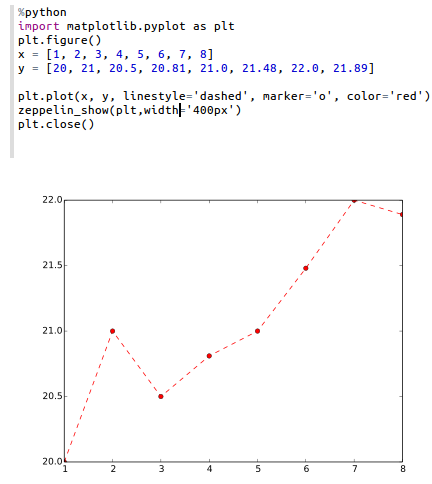Python 2 & 3 Interpreter for Apache Zeppelin
Configuration
| Property | Default | Description |
|---|---|---|
| zeppelin.python | python | Path of the already installed Python binary (could be python2 or python3). If python is not in your $PATH you can set the absolute directory (example : /usr/bin/python) |
| zeppelin.python.maxResult | 1000 | Max number of dataframe rows to display. |
Enabling Python Interpreter
In a notebook, to enable the Python interpreter, click on the Gear icon and select Python
Using the Python Interpreter
In a paragraph, use %python to select the Python interpreter and then input all commands.
The interpreter can only work if you already have python installed (the interpreter doesn't bring it own python binaries).
To access the help, type help()
Python environments
Default
By default, PythonInterpreter will use python command defined in zeppelin.python property to run python process.
The interpreter can use all modules already installed (with pip, easy_install...)
Conda
Conda is an package management system and environment management system for python.
%python.conda interpreter lets you change between environments.
Usage
get the Conda Infomation:
%python.conda infolist the Conda environments:
%python.conda env listcreate a conda enviornment:
%python.conda create --name [ENV NAME]activate an environment (python interpreter will be restarted):
%python.conda activate [ENV NAME]deactivate
%python.conda deactivateget installed package list inside the current environment
%python.conda listinstall package
%python.conda install [PACKAGE NAME]uninstall package
%python.conda uninstall [PACKAGE NAME]
Docker
%python.docker interpreter allows PythonInterpreter creates python process in a specified docker container.
Usage
activate an environment
%python.docker activate [Repository] %python.docker activate [Repository:Tag] %python.docker activate [Image Id]deactivate
%python.docker deactivate
Here is an example
# activate latest tensorflow image as a python environment
%python.docker activate gcr.io/tensorflow/tensorflow:latest
Using Zeppelin Dynamic Forms
You can leverage Zeppelin Dynamic Form inside your Python code.
Zeppelin Dynamic Form can only be used if py4j Python library is installed in your system. If not, you can install it with pip install py4j.
Example :
%python
### Input form
print (z.input("f1","defaultValue"))
### Select form
print (z.select("f1",[("o1","1"),("o2","2")],"2"))
### Checkbox form
print("".join(z.checkbox("f3", [("o1","1"), ("o2","2")],["1"])))
Matplotlib integration
The python interpreter can display matplotlib figures inline automatically using the pyplot module:
%python
import matplotlib.pyplot as plt
plt.plot([1, 2, 3])
This is the recommended method for using matplotlib from within a Zeppelin notebook. The output of this command will by default be converted to HTML by implicitly making use of the %html magic. Additional configuration can be achieved using the builtin z.configure_mpl() method. For example,
z.configure_mpl(width=400, height=300, fmt='svg')
plt.plot([1, 2, 3])
Will produce a 400x300 image in SVG format, which by default are normally 600x400 and PNG respectively.
In the future, another option called angular can be used to make it possible to update a plot produced from one paragraph directly from another
(the output will be %angular instead of %html). However, this feature is already available in the pyspark interpreter.
More details can be found in the included "Zeppelin Tutorial: Python - matplotlib basic" tutorial notebook.
If Zeppelin cannot find the matplotlib backend files (which should usually be found in $ZEPPELIN_HOME/interpreter/lib/python) in your PYTHONPATH,
then the backend will automatically be set to agg, and the (otherwise deprecated) instructions below can be used for more limited inline plotting.
If you are unable to load the inline backend, use z.show(plt):
%python
import matplotlib.pyplot as plt
plt.figure()
(.. ..)
z.show(plt)
plt.close()
The z.show() function can take optional parameters to adapt graph dimensions (width and height) as well as output format (png or optionally svg).
%python
z.show(plt, width='50px')
z.show(plt, height='150px', fmt='svg')

Pandas integration
Apache Zeppelin Table Display System provides built-in data visualization capabilities.
Python interpreter leverages it to visualize Pandas DataFrames though similar z.show() API,
same as with Matplotlib integration.
Example:
import pandas as pd
rates = pd.read_csv("bank.csv", sep=";")
z.show(rates)
SQL over Pandas DataFrames
There is a convenience %python.sql interpreter that matches Apache Spark experience in Zeppelin and
enables usage of SQL language to query Pandas DataFrames and
visualization of results though built-in Table Display System.
Pre-requests
- Pandas
pip install pandas - PandaSQL
pip install -U pandasql
In case default binded interpreter is Python (first in the interpreter list, under the Gear Icon), you can just use it as %sql i.e
first paragraph
import pandas as pd rates = pd.read_csv("bank.csv", sep=";")next paragraph
%sql SELECT * FROM rates WHERE age < 40
Otherwise it can be referred to as %python.sql
IPython Support
IPython is more powerful than the default python interpreter with extra functionality. You can use IPython with Python2 or Python3 which depends on which python you set zeppelin.python.
Pre-requests
- Jupyter `pip install jupyter`
- grpcio `pip install grpcio`
- protobuf `pip install protobuf`
If you already install anaconda, then you just need to install grpcio as Jupyter is already included in anaconda. For grpcio version >= 1.12.0 you'll also need to install protobuf separately.
In addition to all basic functions of the python interpreter, you can use all the IPython advanced features as you use it in Jupyter Notebook.
e.g.
Use IPython magic
%python.ipython
#python help
range?
#timeit
%timeit range(100)
Use matplotlib
%python.ipython
%matplotlib inline
import matplotlib.pyplot as plt
print("hello world")
data=[1,2,3,4]
plt.figure()
plt.plot(data)
We also make ZeppelinContext available in IPython Interpreter. You can use ZeppelinContext to create dynamic forms and display pandas DataFrame.
e.g.
Create dynamic form
z.input(name='my_name', defaultValue='hello')
Show pandas dataframe
import pandas as pd
df = pd.DataFrame({'id':[1,2,3], 'name':['a','b','c']})
z.show(df)
By default, we would use IPython in %python.python if IPython is available. Otherwise it would fall back to the original Python implementation.
If you don't want to use IPython, then you can set zeppelin.python.useIPython as false in interpreter setting.
Technical description
For in-depth technical details on current implementation please refer to python/README.md.
Some features not yet implemented in the Python Interpreter
- Interrupt a paragraph execution (
cancel()method) is currently only supported in Linux and MacOs. If interpreter runs in another operating system (for instance MS Windows) , interrupt a paragraph will close the whole interpreter. A JIRA ticket (ZEPPELIN-893) is opened to implement this feature in a next release of the interpreter. - Progression bar in webUI (
getProgress()method) is currently not implemented. - Code-completion is currently not implemented.
